UM1974 Rev 9 19/85
UM1974 Hardware layout and configuration
84
6.3.4 Using ST-LINK/V2-1 to program and debug an external STM32
application
It is very easy to use the ST-LINK/V2-1 to program the STM32 on an external application.
Simply remove the two jumpers from CN4, as shown in Figure 10 and connect the
application to the CN6 debug connector according to Table 5.
Note: SB111 NRST (target STM32 RESET) must be OFF when CN6 pin 5 is used in an external
application.
Table 5. Debug connector CN6 (SWD)
Pin CN6 Designation
1 VDD_TARGET VDD from application
2 SWCLK SWD clock
3 GND Ground
4 SWDIO SWD data input/output
5 NRST RESET of target STM32
6 SWO Reserved

